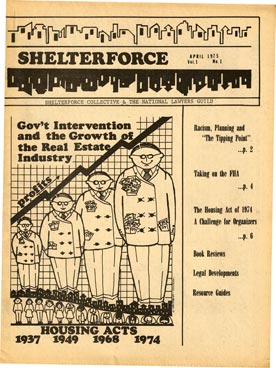In the November 25, 1995, New York Times, board member Peter Dreier challenges the banking industry’s attempts to gut the Community Reinvestment Act. “The banking industry’s short sighted attack on the Community Reinvestment Act is a dagger pointed at the heart of our cities,” Dreier concludes in “Redlining; Not Red Tape,” which ran in the Times’ Op-Ed section.
“Boston’s West End 35 Years After the Bulldozer” also by Peter Dreier (Planning, August 1995) describes the recent closing act of an urban renewal project that began in the 1950s. The West End, a working class Boston neighborhood situated on 52 acres, was torn down because it was “deteriorated” beyond reclaim. In its place rose a complex of high-rise luxury apartments complete with tennis club and swimming pools. “Today, most in the field view the wholesale destruction of the West End as an example of the worst kind of urban renewal: using the wrecking ball to destroy low-income communities and replace them with enclaves for the affluent.” The destruction of the West End helped spur other neighborhoods to organize, says Dreier, and helped bring about HUD guidelines that “obliged city planning agencies… to emphasize neighborhood rehabilitation, low-rent housing, and community participation.”
But the West Enders didn’t just go away; they remained connected and in the 1980s had the opportunity to recreate a small portion of their one-time community on a 1.5 acre parcel that had not been developed. Soon, many West Enders may return to one of the 183 units being built in Lowell Square, as the site was named.
“The CRA has been one of the most effective community development programs in recent history.” writes Board president John Atlas in the September/October issue of New Jersey Reporter. The article, “Banking on the Inner City,” examines the history and accomplishments of the Act and its current precarious condition.
Board members Randell Allston, Phyllis Salowe-Kaye, and Patrick Morrissy each received organizing grants from the Campaign for Human Development for their organizations (Donald Jackson Neighborhood Corporation, NJ Citizen Action, and HANDS Inc., respectively).
The Annie E. Casey Foundation renewed its editorial development grant to NHI/Shelterforce.



Comments